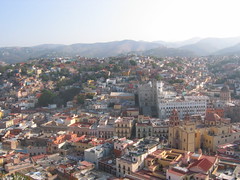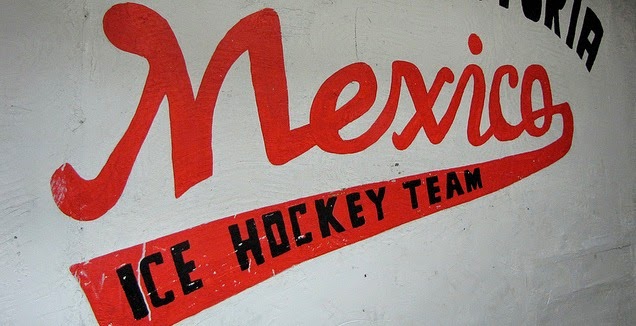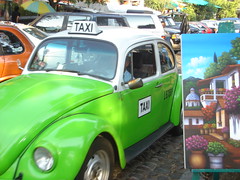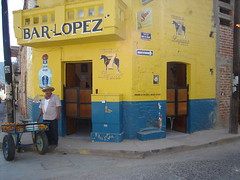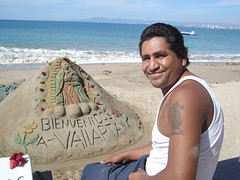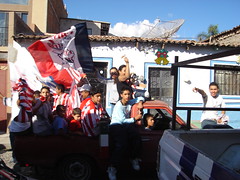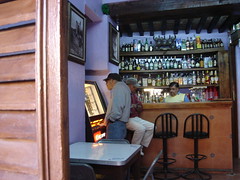 San Miguel’s cantinas
San Miguel’s cantinasBy David Agren, Dec 8, 2006
Shortly before 5pm on a chilly Wednesday afternoon, an old- timer, clutching a cane, pushed through the wooden doors of Cantina La Colonia, a drinking establishment on Insurgentes in San Miguel de Allende. After approaching the bar, he ordered a generous shot of Gran Centenario Reposado Tequila and then proceeded to the tiny restroom behind a curtain in the corner. Upon emerging, he paid 30 pesos, took a sip from the shot glass before pouring the rest of the tequila into a red disposable cup and leaving the premises.
Ramon García’s family has owned Cantina La Colonia on Insurgentes since 1949.
Cantinas such as La Colonia generally sell alcohol in simple establishments to an older, less-affluent clientele drawn from the municipality’s barrios and ranchos. They generally open early and serve customers until midnight, seven days a week. Although similar to bars, cantinas usually lack polish and are governed by different licensing regulations. They’re also a throwback to days gone by, when only men would imbibe at such places and the tipplers were supposedly all macho. And while cantinas are still commonplace, business in many establishments isn’t exactly brisk.“In the old days, all the cantinas had a lot more people,” said Ramon García, owner of Cantina La Colonia.
Cantinas, however, live large in San Miguel de Allende’s municipal lore. Back in the 1960s, members of the Beat Generation, including Neal Cassady and Jack Kerouac, would populate La Cucaracha, perhaps the area’s most legendary drinking establishment. Twenty-eight years after Cassady’s death on the railroad tracks heading toward Celeya, cantinas still dot most San Miguel de Allende neighborhoods, providing a cheap spot to drink beer and socialize with the Mexican population. In some cases, though, cantinas are tourist attractions and cater to both locals and foreigners in atmospheres that are genteel and not entirely authentic. And at places like La Cucaracha (cockroach in Spanish) and El Gato Negro (The Black Cat), the crowds can be decidedly young at times.
At Cantina La Colonia, owner Ramón García tends bar every day in a cheery establishment, which recently moved one door down the street. (He rented the old corner location at Insurgentes and Hernández Macías to a furniture store.) In the new location, he painted the walls mauve. It has three simple Corona-branded tables, a television set, a jukebox and a small shrine to the Virgin of Guadalupe. He figured about 40 people could squeeze in at any given moment. Although possibly imposing for a foreigner passing by the swinging doors—the kind straight out of an old western movie—García rejects the idea of a cantina being an unsafe or unwelcoming place.
“The myth is that there were really macho people (in here),” he said between drags of a Marlboro cigarette. And he listed another fiction about cantinas: “That there used to be people here many years ago who had knives and guns.”
As a result, García said that foreigners—and some Mexicans—“Wouldn’t enter any cantina ... they were scared they would get beat up or that they could be killed.”
Cantina La Colonia first opened in 1949, the year García was born. He grew up in the cantina his father started shortly after moving from Mexico City. “For my father, this was a good business,” García said.
Since assuming control of the cantina, he said business has slipped due to the general economic malaise that has settled over Mexico for the past 25 years. (Last week, though, it was the cold weather that kept customers at home, and one night he closed early at 8:30pm.) Garcia also groused about the lack of a local industrial base and the dependence on tourism jobs, which he said don’t pay all that well.“San Miguel lives—for me—for nothing more than two things: artisans and drunks,” he said somewhat sarcastically.“Nowadays, the situation is [economically] pretty critical. Everything is going up in price and people don’t earn all that much money.”
Mostly Mexicans patronize his cantina—only about 20 percent of the clientele is foreign. Bottled beer is the most commonly ordered drink, followed by tequila. (García only sells Grupo Modelo products because the brewery, which makes Corona, Victoria and Negra Modelo, offered him a cash payment for signing an exclusivity deal.) Cantina La Colonia doesn’t serve food because cantinas are not allowed to serve it. The jukebox, loaded with a surprising variety of music ranging from Latin rock groups such as Maná to ranchero crooners such as Vicente Fernández, swallows an enormous quantity of coins. Cantina La Colonia almost never has live music—another thing forbidden by municipal rules. (Cantinas also can’t impose a cover charge.) Rules aside, bars, nightclubs and even strip joints are pulling customers away from cantinas, according to García, who lamented the large number of liquor licenses granted in the city center. “San Miguel is extremely saturated with bars,” he commented.
Silvia Hernández, a secretary in the Fiscalización office at city hall, said the municipality grants liquor licenses after consulting with the department of urban development and the general guidelines set out by the ayuntamiento (municipal council). As for cantina permits, she said few applications are made and most potential licensees seek permission to sell beer in small mom-and-pop shops.
And while bars and cantinas are different, some establishments blur the distinction. At La Coronela on the corner of San Francisco and Relox, the atmosphere is classy with large portraits of movie stars from the golden age of Mexican cinema gracing the walls. The music—a song from the sappy Mexican pop sextet RBD blared from the television during a recent visit—hardly seemed apt for a cantina. The establishment caters to both locals and foreigners, but in a departure from other cantinas, it hires well-dressed bartenders and waiters, each of whom declined to comment on the record for this newspaper.
Farther out from Centro, down Canal Street, Bar Casanova seemed a more authentic spot to watch the Chivas-Cruz Azul soccer playoff last Saturday evening. At Bar Casanova, a bottle of beer costs only 10 pesos and a waiter wearing a grubby white shirt and faded jeans delivered it to the table. Pictures of dogs playing poker covered some of the walls. Most of the denizens were glued to the match, with Chivas, a beloved squad that only fields Mexican players, drawing the most support. After a Cruz Azul shot hit the post, one inebriated patron yelled,
“Pinche suerte!” (Cantinas are wonderful places to learn off-color Spanish.)
José Luis Perales, a lawyer trained at UNAM, has been the owner of El Gato Negro on Mesones for 23 years. The legendary cantina, which is adorned with photos of Marilyn Monroe, first opened in 1921.
On the other side of Centro from Bar Casanova, El Gato Negro delivers a more eclectic ambiance than virtually any other San Miguel de Allende cantina. Owner José Luis Perales decorated his establishment—the second-oldest cantina in San Miguel de Allende—with Marilyn Monroe memorabilia. El Gato Negro probably vies with La Cucaracha for the unofficial title of the most famous cantina in town.
“[El Gato Negro] has been famous because people comment ... ‘When you come to San Miguel you have to come to El Gato Negro,’” Perales explained.The landmark cantina on Mesones dates back to 1921. The original owner had a business delivering fuel, and a black cat was its mascot. Sort of by default, the cantina gained its name from the fuel company’s mascot, according to Perales. And while it was once a male bastion, Perales said that changed in the 1970s as Mexican women began receiving more legal rights and social customs changed. Nowadays, pretty much any sober person over the age of 18 can drink in a cantina.
“If you have a voter’s credential and it says 18 years old, you can enter,” he said.
Perales, like Ramón García at Cantina La Colonia, grew up in the cantina business. But unlike his competition, he previously studied law at the National Autonomous University of Mexico (UNAM). Although he is a lawyer, Perales said, “I prefer working in a bar.”
Perhaps topping El Gato Negro in notoriety is La Cucaracha—but just barely. Esquire magazine once dubbed La Cucaracha one of the 10 best bars in the world. Located on Zacateros—it moved from its original location by the Jardín about a decade ago—it draws a mixed crowd of locals during the week and foreigners and tourists on the weekend.But beyond the plain and easy-going ambiance, history is La Cucaracha’s biggest calling card. The Beat Generation frequented La Cucaracha in the 1960s. Legend has it one writer gave writing lessons upstairs in order to cover his bar bill. Ramón García said La Cucaracha’s original owner was “a good promoter” who courted the American writers. “The Americans used to arrive and give him their checks,” Garcia explained. “If there wasn’t any money, it wasn’t important.”
Due to its notoriety, business is seemingly better at La Cucaracha than at pretty much any other cantina, including García’s La Colonia, which isn’t really thriving but, according to the owner, still provides an OK living. “It’s a business that isn’t especially profitable,” García said. “But it’s livable.”
Published in Atencion San Miguel
